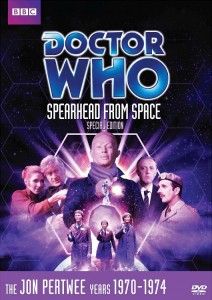 Well, it’s been a couple of weeks, but I’m finally back with the twenty-fifth instalment of Who Review. This week, we enter a new era of Doctor Who with Spearhead From Space.
Well, it’s been a couple of weeks, but I’m finally back with the twenty-fifth instalment of Who Review. This week, we enter a new era of Doctor Who with Spearhead From Space.
EPISODES
Spearhead From Space (4 Episodes)
BROADCAST DATES
3 – 24 January 1970
THE DOCTOR
Jon Pertwee
THE COMPANIONS
Liz Shaw
THE EPISODES
It’s the dawn of a new era for Doctor Who: the start of a new decade (the 70’s), a new Doctor in Jon Pertwee, a new status quo as the Doctor finds himself exiled on Earth, a new companion in Liz Shaw, a new role as advisor to Brigadier Lethbridge-Stewart and UNIT, and most importantly…colour!
Exiled to Earth and prevented from travelling through time by the Time Lords at the end of The War Games, The Doctor arrives in 1970 England, exiting the TARDIS and collapsing to the ground. He is discovered by a UNIT patrol and taken to a nearby hospital.
His arrival on Earth is accompanied by a strange, unnatural meteor storm that showers down on Oxley Woods. A local poacher, Sam Seeley, discovers a strange plastic polyhedron at one of the meteor crash sites.
Meanwhile, Doctor Elizabeth Shaw arrives at UNIT HQ to interview for the position of science advisor to the taskforce. She meets with Brigadier Lethbridge-Stewart, commander of UNIT, and expresses distain at his claims that aliens have interacted with Earth in the past. During the discussion, UNIT officers contact the Brigadier and advise him that they’ve found a man claiming to be The Doctor and have also located the TARDIS. He orders guards posted at the TARDIS and he and Liz head for the hospital.
At the hospital, the attending medical staff discovers The Doctor’s alien physiology. Overhearing the staff’s discussion, an orderly calls the local press and informs them of the arrival of “a man from space.” The hospital is soon overrun by nosy reporters. When the Brigadier and Liz arrive they are inundated with questions about the Doctor and the meteor storm.
Pushing through the reporters, they enter the Doctor’s room, where the Brigadier fails to recognise the Doctor due to his change of appearance. Despite this, he makes preparations to have The Doctor transported to UNIT HQ.
Before that can happen, the Doctor is kidnapped by a mysterious man called Channing and his lackeys, who entered the hospital with the reporters. They strap him into a wheelchair and wheel him away. Fortunately, the Doctor manages to escape in the wheelchair. He attempts to return to the TARDIS but is shot by a UNIT soldier guarding the time machine. The Doctor is taken back to the hospital and the Brigadier has the TARDIS transported to UNIT HQ.
Having failed to kidnap The Doctor, Channing travels to a nearby plastics factory and hypnotises the manager, seizing control of the facility. It is soon revealed that the plastic polyhedron is a power unit for the disembodied alien intelligence known as the Nestene Consciousness. The Consciousness is able to animate plastic humanoid figures known as Autons and the plan is to use the factory to create Autons to replace human leaders and people in positions of power. Channing is one such figure, a detailed human-looking facsimile. He dispatches other Autons to retrieve the polyhedron from Seeley.
Finally convincing the Brigadier that he is who he says he is, The Doctor enlists Liz’s aid in uncovering the Nestene plot. He is too late to prevent Channing activating the Autons across Britain and the constructs begin a killing spree.
The Doctor, however, is able to create an electroshock device that he believes will disable the Autons. He and Liz join UNIT in an assault on the plastics factory. While UNIT troops battle the Autons, Liz and The Doctor make their way inside, where they are confronted by an octopus-like plastic creature created by the Nestene power units. While the Doctor battles the creature, Liz uses his device to shut the creature down. As the Nestene Consciousness dies, the Autons shut down.
Fearing that the Nestenes may one day return, the Brigadier asks the Doctor for help. Exiled to Earth and with a malfunctioning TARDIS, The Doctor agrees to join UNIT in exchange for facilities to help repair his time machine. The Brigadier also agrees to provide him with a vintage car. At the Doctor’s insistence, Liz agrees to stay on as his assistant.
MY THOUGHTS
Spearhead From Space is a solid storyline that, first and foremost, achieves the goal of introducing us to the new status quo. The Doctor’s exile to earth, his new role as a member of UNIT, his new companions and associates are all established by the end of the story. What really makes the story stand out, however, is the introduction of the new Doctor himself.
Unfortunately, these elements are greater than the whole, as the storyline itself lacks a strong central focus and seems to exist merely to accommodate the introduction of the elements listed above. A stronger plot and more memorable villain could have made Spearhead an absolute classic. Instead, it is a solid story made memorable by a couple of standout performances and memorable moments.
Spearhead From Space is partially based on a story written by screenwriter Robert Holmes for the 1965 movie “Invasion.” Some sections of dialogue in Spearhead are identical to those in the earlier movie. Unfortunately, “Invasion” is not yet available on DVD so I don’t know just how similar the two stories are.
THE DOCTOR
Almost instantly, Jon Pertwee establishes his approach to the Doctor and makes the role his own. Gone is the absent-minded paternal figure of the Hartnell era or the bumbling cosmic hobo of the Traughton years. Pertwee is intelligent, confident, witty and highly charismatic. He is a tall, imposing figure that dominates every scene he’s in. In sharp contrast to Troughton, Pertwee’s dress sense is stylish and immaculate, adopting the Mod fashion sensibilities and flair.
He’s also a man of action, fulfilling the action hero role previously reserved for the male companions, especially Steven and Jamie. This is a major shift in the Doctor/Companion dynamic and one that sets the standard for these relationships for this point onwards.
Most notably, though, is the touch of dry humour and wit that Pertwee brings to the role. Prior to Doctor Who, Pertwee was known primarily for his comedy roles, most notably his 17 year stint on BBC radio show The Navy Lark as well as appearing in several Carry On movies. His comedic timing is perfect and adds a new, wry element to the Doctor’s persona.
Pertwee is also the first and only doctor to sport a tattoo, which is seen in the first episode of Spearhead when the Doctor is showering. The tattoo is real; Pertwee was an officer in the Royal Navy during World War II and woke up one morning after a drunken night out while in port to find a tattoo on his right arm.
In 1969, Pertwee asked his agent to apply for the role on his behalf. He was surprised to discover that he had already been shortlisted for the role, although he was producer Peter Bryant’s second choice. The first choice, Ron Moody, declined the role, something he later admitted regretting.
Some additional information is revealed about the Doctor’s physiology during this story, most prominently that he and every member of his race have two hearts. We also learn that his blood type is incompatible with a human’s and that he can place himself into a coma when required.
THE COMPANIONS
There is a long-running debate amongst Who fans as to whether Brigadier Lethbridge-Stewart can be considered a companion or not. I would argue that he isn’t; he does not accompany the Doctor on his adventures nor does he fulfil any of the traditional roles other companions do. He is the Doctor’s associate, fulfilling an important role in providing the series with a focal point for the new earth-based direction the show is going in.
Of course, I’ve still included him in the “companions” section of the review…
Liz Shaw is, unfortunately, not one of the more memorable companions to grace the series. Her character’s driving personality trait seems to be scepticism, which doesn’t exactly make her endearing to the audience. Hopefully she’ll develop more as the series progresses, as she is overshadowed by both the Doctor and the Brigadier in Spearhead and runs the risk of fading into the background.
THE VILLAINS
I’ve never really understood the appeal of the Autons. Amongst the Doctor Who recurring villains, the Autons have always struck me as the least interesting. This is no more apparent than in their first appearance. While the idea of manikins coming to life and killing people is a little creepy (and does provide the story with one of its most memorable scenes when manikins in shop windows start moving), the motivations and driving characteristics of the Autons and their master are a little weak and generic.
FINAL THOUGHTS
Spearhead From Space is a solid introduction to the series’ new status quo, dominated by a commanding performance from Jon Pertwee as the new Doctor.
3 Lukes
NEXT
The Pertwee era continues with the arrival of another Doctor Who villain favourite in Doctor Who and the Silurians.









Thank you for your excellent review…I think most fans would concur with your summary of Liz Shaw…I’m taking you to task over your dismissal of the Autons though. Those that grew up during the seventies were absolutely terrified by mannequins that came to life and began killing people. I know people that grew up in England (as kids) during this period who were too scared to walk through the streets of London. I would say that outside the Doctor’s main enemies, the Autons and the mummies from Pyramids of Mars were the two scariest adversaries. As for the Brigadier, he accompanied Troughton through to McCoy…and was considered companiony enough to be invited to be in the Five Doctors. No other companion got to accompany so many Doctors. A couple of interesting things to point out. The Brigadier could not open the Tardis with the Doctor’s key to which (from memory) Pertwee later tells him that it requires his fingerprints to open the door. This would turn out to be a major plot flaw when later the Tardis door could be opened by such things as Telekinesis (Four to doomsday) to just a simple click of the fingers during the current years. Also noteworthy is that Jon Pertwee was the only Doctor to ever release a single. In 1972 he released ‘Who is the Doctor’ which was a tune he ‘sung’ based around the Doctor Who theme. Pertwee had released several children’s records previously including ‘There once was a lady’ and ‘the 3 little fishes’ as well as being featured on several musical soundtracks. And finally John Woodnutt who plays Hibbert went onto appear in Terror of the Zygons and Keeper of Traken…and yes revisiting the first Pertwee season you just can’t wait to get to the second season for Roger Delgado and Katy Manning 🙂
And excluding the current era, it’s far superior to any other debut story!
The Autons just don’t seem all that terrifying to me, although I can understand how they might freak kids out. Maybe it’s simply that I’m seeing them for the first time as an adult. I remeber being terrified of the Zygons when I was young but I’m sure they’ll just seem quant and maybe a little hokey when I finally get to that episode.
The pig homonculus from Talons of Weng Chiang is still creepy, though.
While I won’t argue with the Brigadier’s continued use, I still see him more as a recurring character than an actual companion. He just doesn’t have the standard Doctor/companion relationship with any of the Doctors he serves alongside.
It’s certainly a stronger opening than Hartnell’s, although it’s impossible to compare it to the lost Troughton intro. I think Pertwee is what really sells it as an introduction.
The fact that Jon Pertwee released a Who-related single is just bizarre, but for some reason I must now hear this record!